How does your artistic career starts, and through what changes you been?
Julia Kater (JK): I believe that my interest in making art came from my work in photojournalism, especially after a trip I made to Togo, in Africa. I began to develop my collages in 2005 using the waste from the photos I had. They came from other contexts and were taken without the objective to become part of my artistic work, contrary to what happens today. So, in a way, this beginning was very intuitive. I realized that a photograph could be easily decontextualized through collage, in such a way that the narratives that could be built from there have proven to be an extensive field for a more personal and subjective discourse. I believe that it was from the perception of these possibilities that I started making art.
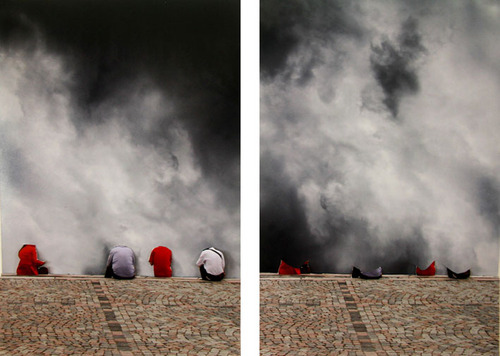
© The useless dream of being, 2011
Tell us about your interest in photography and what kind of research are you carrying out.
JK: Photography is a support that interests me immensely. To experiment with photography and hence converse with its own elements, with the framing, the bidimensionality, for example, to be able to break these ‘rules’ providing materiality to the photography through the collage, to invert its plans and hence change perspective.
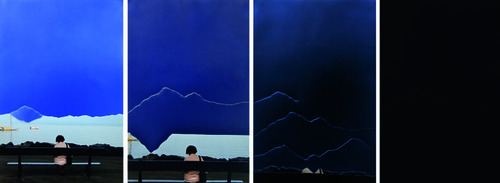
© Didn’t say with words, Silence series, 2010
To rebuild the frontiers between these elements, change the direction in which we formally see the image, like in the video ‘O Tempo do Branco’ [The Time of White], to provoke encounters that only exist due to framing, to establish relations between distinct elements to me are ways to approach the limits of the image, and my research goes in that direction.
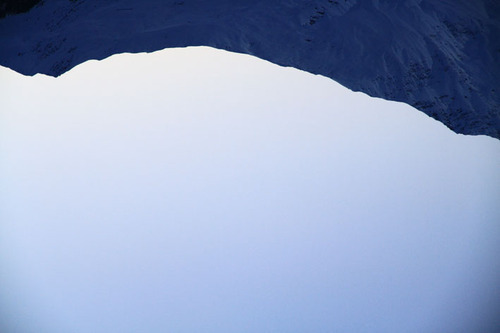
© Tempo do Branco, 2011 Still video, color, 56’’
We have seen that your images have been used to promote the Festival of MOVECINEART of Sao Paulo. What can you tell us of this initiative? Tell us also how do you see the Brazilian art scene and if there are any artists that you particularly appreciate.
JK: I was invited by filmmaker friends who are organizing this festival, to make the poster. I was happy with the invitation, because this is the first festival in Brazil with films dedicated to the arts in general, and I believe that it will be very interesting. And one of my main references is cinema. I really like movies, especially European productions; Ingmar Bergman, Michelangelo Antonioni, etc., and more recently the Greek filmmaker Theo Angelopoulos. I really like how they build a more subjective narrative and how they approach questions like silence, frontier, emptiness, death, and human relations. I try to bring these questions to photography.
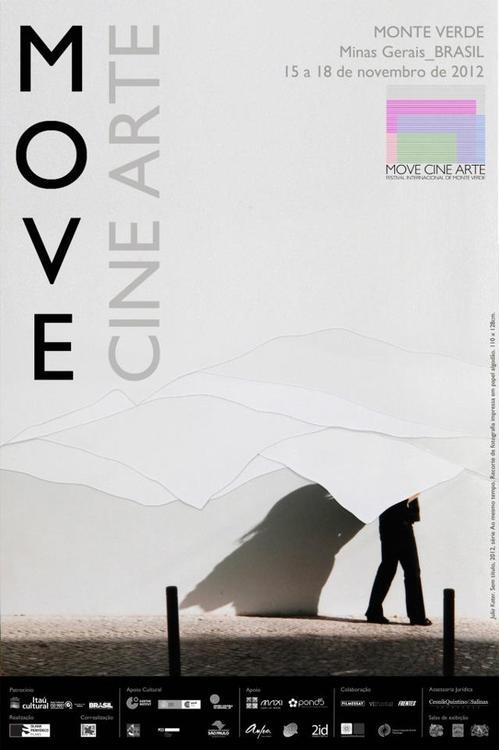
In regards to the arts scene in Brazil, I believe that it is in a very live and active moment right now, and we can see that it is growing and maturing daily.
Digital manipulation of iconographic representation is a recurring theme in your art work. No longer content to watch or contemplate a landscape, but the artist intervenes to change the perception, as if to awaken the view, and seek one’s own reality rather than submit to it.
JK: When I displace the sky from the background to the foreground, when figure becomes background and background becomes figure, a movement is established that implies an organicity between these elements. I have a series called 'Papel Parede’ [Wall Paper], which I believe also relates to this inversion, but this time not between figure and background, but between inside and outside. The wallpaper from the interior of the houses that I have photographed has been displaced to the façade of the house.
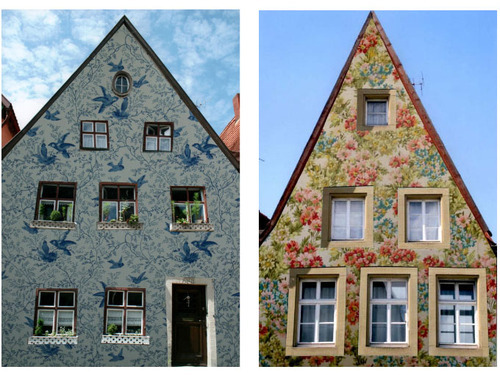
© Untitled, Wall Paper series, 2009
In regards to manipulation, every collage is made manually, never digitally, with tools like Photoshop, etc. To me it is important to have this manual contact with the image, to be able to intervene directly in the surface of the photograph.
The sky appears to us in some of your projects as a liquid blanket that goes beyond space and surrounding it. Undoubtedly there is a break with a normal perspective. We find, as in other seasons of the history of art, the desire to get rid of the classical canons of interpretation.
JK: I’ve always photographed the sky. The impermanence, the transitoriness, its omnipresence, this impossibility of present fixation of it, this has always fascinated me. I always try to photograph images that inhabit my memory, where time seems suspended, like these images of indoor ambient of the series 'Et moi je vous dis’ [And I say to you] (2010). I see these spaces as scenery, where there is no indication of time. With the cutting, I decharacterize the ambient, take away all that is personal, the portraits, the framed pictures, I leave only the frames, replacing the pictures with the image of the sky that evokes movement, transformation.
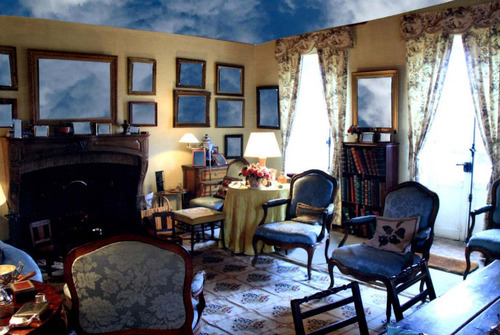
© Julia Kater
In other works, like 'Julliet’, for example, the sky is no longer the sky. It is white, grey, something that plummets, that falls, that moves, overflows, and invades.
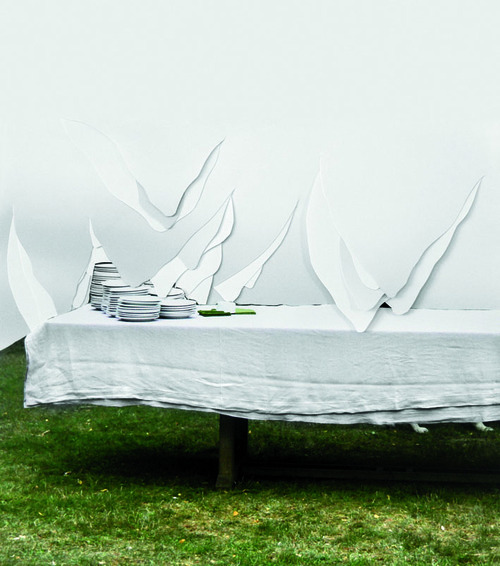
© Juillet, 2011
What are you working on now and what are your plans for the future?
JK: I am currently working on two new series that I began during my residency in Lisbon, Portugal, in July. 'The series Horizons’ (2012) is composed by works that formally represent people partially covered by straight and angular lines of architecture. In these works, two images of the same place are juxtaposed, but in one of them there is a human figure that is absent from the other image. The background, the architecture removes the protagonism of the character, occupying its physical place. Through cutting, this order between figure and background is inverted, and the character then exists underneath the architecture.
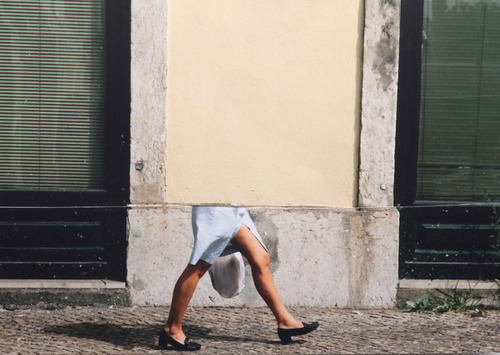
© Untitled, Horizons series, 2012
The series 'At the same time’ (2012) presents images with more than two layers. Here, these cuttings are more organic and may remit to reliefs and landscapes. In this series, the human figure is in the foreground, walking; the cutting brings from the background shapes and layers that seem to fall over and to overlap the character. Differently from the previous series, here the architecture is emptied. It is lost due to the character being photographed in front of a white wall, without information of the existing architecture.
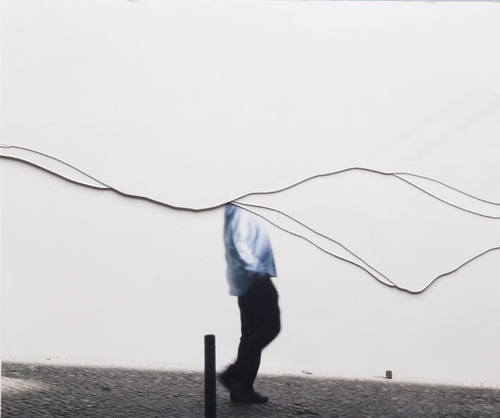
© Untitled, At de same time series, 2012
share this page
